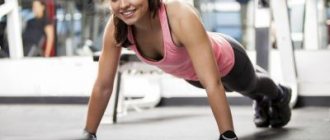Running has a positive effect on the body.
It not only allows you to stay in good shape, but also trains endurance, strengthens muscles, joints and ligaments, develops the respiratory system, improves blood circulation and has a beneficial effect on the condition of blood vessels. However, before running, it is necessary to warm up thoroughly, otherwise there is a risk of injury. Warming up not only prepares joints and ligaments for work, minimizing the likelihood of injury, but also ensures blood flow to the organs. It prepares the heart for running, because during the warm-up it begins to work faster compared to the resting state.
Why does a runner need to warm up?
Warm-up is a set of various exercises that prepare the body for a more serious load. Thanks to it, you can not only avoid injuries, but also make your workouts as effective as possible. The warm-up process warms up the muscles and ligaments, thereby reducing the likelihood of injury while running. Also, warmed muscles work much better, so the effectiveness of your workout increases.
Warming up gradually prepares the heart for stronger loads, and also allows you to saturate your muscles with oxygen due to improved blood circulation. Muscles prepared for exercise are more efficient. Warm-up also triggers the process of enhanced synthesis of hormones, which are responsible for the process of energy production in the body. Any workout is stressful for the body, and a good warm-up will help prepare for the stress. It also gives you psychological readiness for training, because it is impossible to get involved in this process instantly. Thanks to a proper warm-up, training is easier and more effective. You will also avoid injury and heart problems.
Improper or insufficient warm-up can lead to a variety of injuries. The most common among them is sprained ligaments. More serious and unpleasant is a joint injury, in which case you will need long-term rehabilitation. It is much easier to avoid injuries than to treat them later. Lack of warm-up can cause blood pressure surges or lead to heart problems.
Stretching exercises
There are certain recommendations. Stick to them so that stretching brings only benefits:
- Always stretch only warm muscles. Do not start doing exercises without preparation, otherwise the risk of injury will increase.
- Don't try to stretch the muscle too much. If you feel severe pain , stop. A feeling of good tension is enough
- Avoid sudden movements - move smoothly, slowly, stretch the muscles gradually
Post-run stretching: in the park
Post-run stretching: at home
- >
Post-run stretching: in the park
The long-awaited summer season has begun, which means it's time to go for a run. For training in the park to be useful and productive, it is important not only to warm up properly before running, but also to cool down after. In this episode of Fitness Girlfriends, see how to stretch after running.
- >
Post-run stretching: at home
Stretching after running consolidates the results and makes the workout more effective. You already know how to stretch outside immediately after running. In this issue, see the indoor stretching routine.
There is one good principle : first, stay in one position for 20-30 seconds, then, as you exhale, move forward a little more, stretching the muscle a little more. Wait another 20-30 seconds and smoothly complete the exercise.
The simplest and most effective stretching exercises:
- Necks. Slowly turn your head to the side and stay in this position. You should feel the tension in your neck muscles well. Repeat on the other side. It is enough to do the exercise 3-4 times
- Back. Bend your arm at the elbow, lift it up, and place it behind your back. With your free hand, slowly try to pull your elbow back. The shoulders and latissimus dorsi muscles are stretched. Repeat with each hand
- Shoulders. Move your left arm in front of your body to the right. With your right hand, bring your hand closer to your body. Repeat on each side
- Slow bends back. Hold in the limit position
- Side bends. Do it slowly, hold the bend slightly and make mini movements towards the ground
You may ask, why do you need to stretch the muscles of the upper body if it’s mainly your legs that are tensed while running? This is the wrong position. Yes, the lower limbs experience the maximum load. But the back, arms, and neck are also involved in movement . Therefore, they need to pay attention to ensure that their posture is correct and their back does not strain.
Leg stretching exercises:
- The simplest thing: lay out a mat, sit down and spread your legs as wide as possible. Alternately bend toward each leg and then toward the center. Hold in the limit position. Try to stretch as far as possible and keep your back straight
- Bends from a standing position. The same as sitting: alternately, with a straight back, reach for the toes, and then to the center
- Standing stretch. Bend your leg at the knee and pull it towards your stomach with your hands, hold. This relaxes the buttocks and hamstring muscles. And the reverse exercise - move your bent leg back, grab your toe with your hand and pull it towards your buttocks. Stretches the anterior thigh muscle
- To relax your shin, bend one leg at the knee and place the other slightly forward on your heel. Hold the sock with your hand and pull it towards you. The back is bent and in a semicircular position
It is important
You should have a good feel for the muscle you are pulling. Understand when the tension is enough and when it is too tight and needs to be loosened.
Understanding your own body does not come immediately, but with each workout you will be able to stretch better and better. It is advisable not to play loud and intense music on headphones while relaxing - it interferes with concentration. Keep your back straight and your movements smooth, and everything will work out!
Spreader
A great exercise to prepare for running is stretching. It develops well not only the leg muscles, but also coordination of movements. The muscles of the back of the thigh work most actively. Their development is very important, because they are actively involved in the running process. The exercise must be performed within a minute. Get into a stable lunge position, sharply push your feet off the floor and change their position. If at first the left leg was in front, now the right leg should be in its place.
Video. Stretching the leg muscles after running
Stretching your legs and back after running
Stretching after running
Video tutorials for runners: stretching after running
- >
Stretching your legs and back after running
By constantly running, you run the risk of “clogging” your leg muscles, which will lead to muscle blocks. This is also fraught with unstretched knees, a pinched pelvis and too prominent shins. To correct this situation, we recommend doing a small set of exercises to stretch your legs and back after running, right on the street! In this video you will learn how to stretch as effectively and comfortably as possible at any time of the year.
- >
Stretching after running
Triathlon training school for amateurs (IronMan). Post-run stretching routine.
- >
Jumping on a support and jumping out of a half squat
Another exercise that helps prepare for running is jumping jacks. Any stable support of small height will do; its role can be played by a low bench, curb, stone, log, and so on. The exercise warms up the calf muscles, as well as the back and front of the thigh. Regular lunges can strengthen your ankle. Do ten exercises on each leg. Strengthening your calf muscles helps you avoid a number of fatigue injuries.
When jumping out of a half-squat, the knee joint and quadriceps femoris muscle work. A good warm-up of your knees is very important, because they bear a lot of stress while running. Perform three series of ten to twenty jumps, landings should not be hard.
Advice from professionals
Warming up should not cause discomfort; it is needed to prepare your body for stress, so you should not load it right away. Exercises begin to be performed from top to bottom, first stretching the neck, arms and shoulders, body, and then legs. The legs need to be given special attention, because they are the ones that work when running. The pace should be dynamic, but gentle. You need to start slowly and gradually speed up.
The duration of the set of warm-up exercises should be about ten minutes. This time is enough to prepare the body for running and tune it in the right way. First, a light cardio warm-up is performed for one to two minutes. Next, joint gymnastics is performed, which also takes a couple of minutes. Two to three minutes are devoted to dynamic muscle stretching exercises. Next, cardio warming is carried out again and breathing is restored. After such a complex, your body will be completely ready for running.
Joint exercises will help prepare your joints for work. Cardio warming is necessary for better blood flow to the muscles, and dynamic stretching will make them more elastic.
How to do a warm-up routine correctly so as not to harm yourself?
For beginning athletes, a pressing question is: how to warm up before running. And it’s not even about the exercises themselves, but about their sequence. It is better to start from the upper parts of the spine, smoothly moving to the lower ones. A typical warm-up for running might look like this:
- Cervical spine. Start warming up with your neck, making smooth tilts of your head back and forth, left and right. Next, circular rotations of the head are required.
- Hands. We stretch our arms to the sides, standing straight with our feet shoulder-width apart. We do rotations in different directions in the hands, then in the elbow joint, then in the shoulders.
- Frame. To warm up your lower back, you need to tilt your body left and right, back and forth.
- Legs. Next you need to stretch your legs. To do this, first, standing on one leg, bend the second at an angle of 90 degrees and perform rotational movements on it, first in the knee joint, then in the ankle and hip joint. Repeat for the other leg.
- We finish the warm-up with stretching, lunging forward with each leg in turn.
This complex will not take more than 5-7 minutes, but will perfectly prepare the joints and muscles for work. In conclusion, we present a table in which we describe actions that are not recommended to be done during warm-up.
| Action | Why not recommended? |
| Start of warm-up - stretching | There is a risk of injury |
| Breakfast before warm-up | It's better to eat after running |
| Long warm-up | Warming up for more than twenty minutes will lead to the fact that there will be no energy left for the main training. |
Only the right approach to training can give a positive result. And warming up before running plays a decisive role here. Warm-up is especially important in winter, when the unawakened body is affected not only by internal factors, but also by external factors associated with cold air, abundance of precipitation and uneven road surfaces.
Warm-up before the marathon
Warm-up before marathons, half-marathons, and ten-kilometer races follows the same pattern. When performing exercises, you need to monitor their correctness, as well as your breathing. Before short races, you need to pay more attention to warming up, since during marathon races the body continues to warm up during the first kilometers of the race. Before long-distance races, it is recommended to do several short races of 50-70 meters in length with acceleration. Acceleration makes it possible to perfectly warm up all muscle groups that are involved in running. It also stimulates metabolism.











